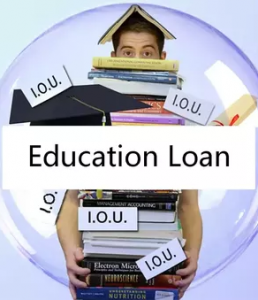Common Misconceptions About Education Loans in India
June 10, 2019
Puneet
Education Loan, Secured Loan, Study Abroad Loan, Study in USA Loan, Unsecured Loan
Getting an education loan to study in India or abroad has become a lot easier in the last decade. Today, the education loan market is swamped with commercial banks as well as Non-Banking Financial Companies (NBFCs) eager to provide both secured and unsecured education loans at competitive interest rates. In fact, students with good academic record and sound family finances can get unsecured education loans of up to Rs 40 Lakhs to study in US through Student Cover.
Education loans have emerged as tool of empowerment for bright students, especially from middle-class families who cannot afford good quality but costly higher education abroad. However, it is seen that people approach for education loans without much research. Many of them hold misconceptions about education loans which if not addressed properly could cause a lot of inconvenience in future.
Common Misconceptions About Education Loans in India
In this blog, Student Cover brings you some of the common misconceptions that people in India have about education loans.
No repayment worries till course completion
This is a common misconception that people have with regard secured education loans from commercial banks. Almost all secured education loans, except those provided by NBFCs, provide moratorium period on repayment. It means that a student who has taken secured education loan from a commercial bank is not required to start paying the EMI (Equated Monthly Installments) as soon as the education is sanctioned by that bank. A student has to start repaying the loan in the form of EMI only after six months have passed after the date of completion of the course. This gives the student an opportunity to repay the loan after getting a job.
However, this does not mean that the lender bank will waive off 2 years’ worth of interest on education. The interest that is due gets added to the principal amount which has to be repaid with interest in the form of EMIs. For example, if a student has taken an education loan of Rs. 10 lakhs at 12% RoI (Rate of Interest) for 7 years and whose repayment starts two-and-a-half years later, his or her accumulated interest for those two-and-a-half years is say, Rs. 2.40 Lakhs (approx.), his EMI will be calculated on
Rs. 10 Lakhs(principle) + Rs. 8.4 Lakhs (total Interest amount for 7 years) + Rs. 2.4 (total Interest amount for 2 years) lakhs = Rs. 20.8 Lakhs.
Therefore, it is advised that wherever possible, a student should pay at least the interest component of the education loan so that it doesn’t get added to the principal later.
Interest starts the moment loan is sanctioned
This misconception is quite the opposite of that mentioned above. The interest meter does not start ticking the moment loan is sanctioned by the bank or the NBFC. It is only when the money is disbursed by the bank to the student’s account that the bank starts charging the interest. In other words, even if a loan is sanctioned for Rs 10 Lakhs, no interest is charged from the student till the amount gets transferred from the bank to the student’s account.
It is therefore advised that students should seek disbursement of the loan amount only when the need arises. Getting the entire loan amount disbursed to one’s account at the start of the course will generate interest for the entire 2 year period irrespective of when the student actually used the money.
I can claim tax returns on EMI!!
Nope, Unlike other forms of debt, education loan, especially those taken to study abroad in countries like the US are not eligible for income tax benefits. However, under Section 80E of the Income Tax Act, a student or his or her parent can claim tax benefit on the interest component of the education loan. Moreover, there is neither an upper limit either on the interest rate or volume of interest on which one can claim tax benefit.
My EMI will remain constant!!
No, The EMIs depend on the rate of interest at which the bank or NBFC lent money to the borrower. If the interest rate is high, the EMIs would naturally be high and vice versa. However, the rate at which the banks and NBFCs charge interest on loans depends on the rate (Repo rate) at which the Reserve Bank of India (RBI) lends them money. If the RBI increases the lending rate, the banks too will increase their lending rate and vice versa. Hence, a student is advised to be mentally and financially prepared to either pay higher or lower EMIs in the course of his repayment period.
Unsecured loans require nothing!!
Unsecured education loans are loans given without collateral. In simple words, a bank does not demand the borrower to keep either land or property as mortgage in return for education loan provided by it. This does not mean that banks provide unsecured loans without any condition. To get an unsecured education loan, a borrower must prove his or her creditworthiness through CIBIL score, income statement and stable source of income. It also requires a third party with healthy finances to stand as guarantor for the borrower.
Students are therefore advised to ensure that the co-applicant i.e. sponsors/guarantors are financially sound with good CIBIL scores and source of income.
One always gets a loan equal to the value of the collateral!!
 This misconception is prevalent among borrowers seeking secured education loans. Banks and NBFCs that provide secured loans seek collateral in order to minimize their risk. Auctioning of collateral to recover dues is used as a last resort in case of default by the borrower. However, some banks provide loan after discounting the value of the collateral. For example, if a borrower is seeking education loan of Rs. 10 Lakhs and offers to keep his land or property worth the same value, the bank may not provide him Rs 10 Lakhs. Instead, the bank may only provide a loan of value up to Rs. 8.5 lakhs (85% of the value of the land or property). It may ask the borrower to manage the remaining Rs 1.5 Lakhs (15%) on his own.
This misconception is prevalent among borrowers seeking secured education loans. Banks and NBFCs that provide secured loans seek collateral in order to minimize their risk. Auctioning of collateral to recover dues is used as a last resort in case of default by the borrower. However, some banks provide loan after discounting the value of the collateral. For example, if a borrower is seeking education loan of Rs. 10 Lakhs and offers to keep his land or property worth the same value, the bank may not provide him Rs 10 Lakhs. Instead, the bank may only provide a loan of value up to Rs. 8.5 lakhs (85% of the value of the land or property). It may ask the borrower to manage the remaining Rs 1.5 Lakhs (15%) on his own.
It is therefore essential for a borrower to find out the margin at which a bank or any other lending institution provides education loan before approaching it for a secured loan.
Education loans only cover tuition fees!!
While one may require only education loan to pay high fees in India where the cost of living is relatively low, he or she is unlikely to afford manage the living cost in countries like the US, UK, Canada or Ireland. This is because the value of local currency of these countries is very high as compared to Indian Rupee. For example, Re. 1 in India = 0.014 Dollars in the US (1 US Dollar = Rs 69.71). In addition to that, the purchasing power parity is lower in the US as compared to India, which means that for say, for a 1 Liter bottle of water in the US may cost $ 1.5. Which is not very high in terms of USD but when adjusted against India Rupee, it comes out to be Rs. 104.
Hence, lenders, in addition to providing loans to pay tuition fees, also provide for meeting the cost of living in the US. They include cost of fooding, lodging, books, computers, assignments, stationery, and other essentials. They do not include items of luxury, recreation and entertainment.
Students are therefore advised to accurately determine the cost of living in addition to cost of education and seek education loan that meets both academic and living expenses.
We hope that the readers will find the content of this blog informative and useful. Student Cover helps provide education loans to students going abroad for higher studies. For more information on our education loan services and products, students can visit our loan page by clicking on the following link: https://wordpress-615697-2022802.cloudwaysapps.com/loan-services/
Recent Blog Posts

Need help? Chat with us
